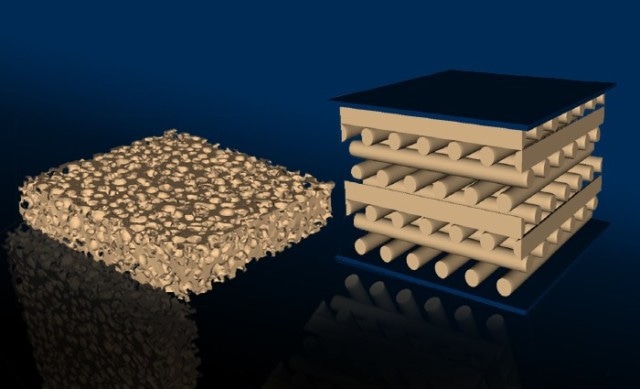May 3 2016
A team of researchers at the Lawrence Livermore National Laboratory have discovered that 3D-printed foam functions better than regular cellular materials, especially in terms of long-term mechanical performance and durability.
 Microstructures of two different foam materials. At left, a traditional open-cell stochastic foam, and a right, a 3D printed foam with the face-centered tetragonal lattice structure. (Credit: Lawrence Livermore National Laboratory)
Microstructures of two different foam materials. At left, a traditional open-cell stochastic foam, and a right, a 3D printed foam with the face-centered tetragonal lattice structure. (Credit: Lawrence Livermore National Laboratory)
Foams are also referred to as cellular solids, and form a vital class of materials that can be applied in numerous products, ranging from shock-absorbing support cushions and thermal insulation to floatation components and lightweight structural. The material is an essential component in several industries such as electronics, automotive, packaging, defense, aerospace, biomedical, and marine.
Conventionally, foams are manufactured using methods that provide a highly non-uniform structure with important dispersion in shape, size, thickness, topology, and connectedness of its constituent cells.
As an enhanced choice, the researchers at the additive manufacturing lab at LLNL recently illustrated the viability of 3D printing uniform foam structures using a method known as direct-ink-write. As 3D printing requires the use of polymers with specific properties, it is essential to understand the lasting mechanical stability of such printed materials prior to them being commercialized. This is particularly fundamental in applications such as support cushions, where the foam material is exposed to long-term mechanical stresses.
To tackle the stability issue, the LLNL group conducted accelerated aging experiments where samples of both conventional stochastic foam and 3D-printed materials were exposed to a set of high temperatures under a steady compressive strain. The mechanical response, stress condition, and permanent structural damage of each sample were observed for one year or even longer in some cases. A technique known as time-temperature-superposition was subsequently used to quantitatively represent the evolution of such properties over many years under ambient conditions.
This research proved that 3D-printed materials wear slowly, meaning that they retained their structural and mechanical features better than the conventional materials. Native rubber i.e. elastomer, containing each foam revealed precisely the opposite effect. The rubber in the printed material wore out faster than the equivalent rubber used in the conventional foam.
To achieve additional insight into the reason why the printed cellular material possesses excellent long-term stability, the LLNL team imaged the 3D micro-structure of individual foam samples with X-ray computed tomography, and carried out finite-element analysis of the stress distribution within each micro-structure. It was observed that there is a greater difference in local stresses within the stochastic foam, with points of intense stress drastically higher than the highest stress points within the highly uniform 3D-printed foam.
The research has been published in the Scientific Reports journal (April 27 edition).
3D printing of foams offers tremendous flexibility in creating programmable architectures, customizable shapes and tunable mechanical response. Now that our work strongly indicates superior long-term stability and performance of the printed material, there is no reason not to consider replacing traditional foam with appropriately designed 3D-printed foam in specific future applications.
Amitesh Maiti, Lawrence Livermore National Laboratory
Other co-authors from Livermore include Ward Small, James Lewicki, Todd Weisgraber, Eric Duoss, Sarah Chinn, Mark Pearson, Christopher Spadaccini, Robert Maxwell and Thomas Wilson.
The team was also supported by National Security Campus, Missouri where some of the initial aging experiments were conducted.